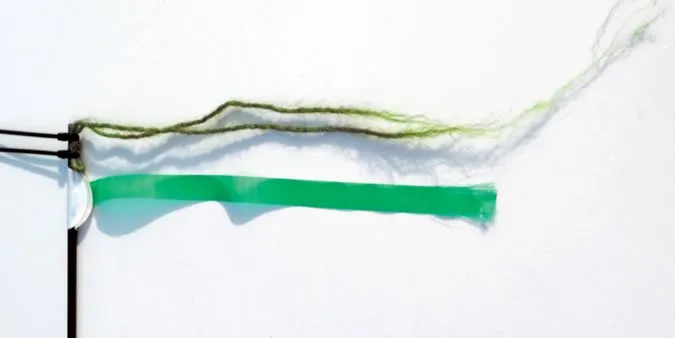Fixed wind indicators tell the direction of the wind relative to the boat, but it is the flow within a few inches of the sail that really matters (see Top-notch Wind Indicators, January 2018).
The simplest way of gauging the flow close to the cloth is by observing the motion of ribbons or yarns (telltales) attached to the sides of the sails-when the flow is attached to the sail, streaming aft, the telltales also stream aft, and when the flow is stalled and turbulent, they droop or swirl. It’s your own private wind tunnel demonstration.
Unlike fixed wind indicators, they are maintenance items. Made of light sailcloth or yarn, they take a beating from the wind and when sails are handled, requiring inspection every year and replacement every few, depending to your sailing habits. We could use heavy materials and extend their lives, but then they wouldn’t stream in light winds.
What We Tested
We tested ribbon telltales from Davis Instruments and 70s cassette tapes. We tested wool yarn telltales from West Marine, and acrylic/wool blend from the knitting basket.
How We Tested
We observed samples in use on sails through many years. We also attached samples of Davis Airflow Telltales, West Marine yarn telltales, knitting yarn, and cassette tapes and on fiberglass wands and drove around with them on the rooftop for hours at 60 mph to compare durability.
Observations
Ribbon vs. Yarn. Ribbons-either the Davis Air-Flow or home-made strips cut from spinnaker cloth with a hot knife-are sensitive and reasonably durable. They are secured to the sail with self-adhesive spinnaker repair tape, and their only real fault is a tendency to stick to the sail when wet with rain or spray (spraying with McLube Sailkote helps keep them dry).
Old cassette recording tape makes even more sensitive ribbons, with an even greater tendency to stick. Wool yarn, on the other hand is less sensitive, less prone to sticking, and dries more quickly. They are commonly installed with the same self-adhesive circles as ribbons, but they can also be attached by threading them through the sail cloth and placing a knot on each side. Leach yarns on the main are often tied to batten pockets.
A hidden advantage of relatively weak materials is that if they should become knotted around a lazy jack line or something similar, they will tear away without damaging the sail. They should always be weaker than the sail.
We like that the Davis and West Marine telltales have different colors for port and starboard, but we still prefer to mount the starboard telltales six inches lower than the port telltales. This way, even at night when color vision fades, we can still tell which is streaming. The yarn tails didnt handle the 60 mph test quite as well, but how many sails see sustained winds that intense? In actual use, yarn seems to stay on the sail better.
Ribbons
Surface area gives ribbons the edge in light wind, so long as they are dry.
Davis Air-Flow Tels
Quickly installed with self-adhesive spinnaker cloth circles, these are the standard on dinghy sails. They held up better than yarn in our 60-mph torture test, although few sails will ever see sustained winds in that range. They cost $10 for fourteen 8-inch ribbons (seven sets of red and green). They are more sensitive in light winds than some others we tried.
Bottom line: Best Choice.
Ronstan Telltales
Like the Davis telltales, these are simple nylon ribbons attached with self-adhesive tape circles.
Bottom Line: Recommended.
Cassette Tape
We occasionally used these on dinghies in our quest for the best possible light air indicator. They often got stuck on the sail due to spray, and after a capsize they wouldnt work at all for the next 5-10 minutes, plastered tightly to the sail. They did not survive the 60 mph test, snapping off within 15 minutes. Replacement in the field was frequent, but free.
Bottom line: You might like them on your dinghy, but their fragility means they are more likely to wind up joining the rest of the plastic in the ocean.
Yarn
Natural wool has long been a sailors friend. Infinitely adaptable, easy to replace wool tell tales are the obvious choice for the budget-minded sailor.
West Marine Sail Telltales
West Marine has led the way in developing eco-friendly options for boaters. Natural wool is most water repellent and thus is the traditional choice. They don’t fly as easily as ribbon, but they also dry more quickly and are less prone to sticking to the sail. They are less than 6 dollars for fourteen 8-inch yarns (seven sets of red and green).
Bottom Line: Recommended.
Generic
It is easy to make your own telltales. Natural wool is preferred, but acrylic and acrylic/wool blends are also effective. Avoid cotton-it dries too slow and degrades quickly.
Sail tape does not always hold, so the simplest installation is to use a needle and thread to pull the yarn through, and then knot on each side. Installed this way, they are more durable for cruisers than ribbons.
They can also be tied to batten ends. Color doesn’t matter on the mainsail leach, and so long as they are staggered vertically on the jib, it doesn’t matter there either. Dark colors are best.
Bottom line. Recommended.
Conclusions
We continue to use both ribbons and yarn telltales, without strong preference. Ribbon is better in light winds, yarn is better in foul weather, and both require service every few years, whenever sails are laid out for inspection.





































Thanks for the refresher on sail-mounted telltales. What about the usefulness of telltales on shrouds? If useful, which are good there? How to read them?
We have used cassette tape tied to port and starboard shrouds for years. They work well, but don’t last long. But, so what, we have plenty of tape.